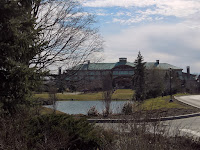The second day of the
Professional Abatement Contractors of New York's (PACNY's) 22nd Annual Environmental Conference started with a
continental breakfast in the Vendor/Exhibit Hall at the
Turning Stone Casino, which seemed fuller than previous conferences. Ms. Deb Sanscrainte, of
Aramsco & the Conference Chair and Mr. Joseph Cantone, of
Colden Corp. & the PACNY President welcomed everybody & gave us opening remarks.
 |
| Ms. Reinstein discussing Asbestos Exposure |
The first presenter of the day was the keynote speaker Ms. Linda Reinstein, of the
Asbestos Disease Awareness Organization (ADAO) and the
Global Ban Asbestos Network (GBAN), discussing "Mitigating Asbestos Exposure in the 21st Century." It was a rousing presentation and very inspirational. In addition, Ms. Reinstein announced the launch of her new
kNOwAsbestos website. A one-stop resource guide for you to learn about
asbestos and what to do about it. Our next speaker was Mr. Michael Misenhimer, of the
Northeastern Subcontractors Association (NESCA). His presentation was on "The Fight to Get Paid - Practical Strategies for Subcontractors" and included a valuable 11 point hand-out that he was kind of enough to allow us to add to our dropbox folder (under conference presentations) on Future Environment Designs website's
resource page. Mr. Misenhimer's presentation was on the 11 point hand-out that recommended that subcontractors investigate the
General Contractor (i.e., credit evaluation); condition your bid on your payment terms, establish entitlement to prompt payment; clarify retainage provisions; use your payment bond rights and other important information on making sure you get paid-in-full. His
hand-out included example letters to use for each of the 11 points. The end of his presentation brought us to the first break and time in the Vendor/Exhibit Hall.
 |
| Mr. Michael Misenhimer & his 11 Point Hand-out |
We returned from the break to Mr. Richard Clarkson of the
New York State Department of Environmental Conservation (NYS DEC) discussing "Part 360 Revisions and Solid Waste Regulations". Mr. Clarkson's presentation discussed the definition of friable asbestos; when fill must be tested to be reused; what fill must be tested for to be reused; waste transporter registration; and waste reporting & recordkeeping. Our next speaker was Mr. Adam Schrader, of
Ecospect, discussing "Healthy Basement, Healthy Home". Mr. Schrader's presentation discussed the multitude of contaminants that exists in the home and the workplace and wicking/capillary action a source of moisture for floors & walls. After Mr. Schrader's presentation, we broke for a fantastic lunch and more networking opportunities.
 |
| Ms. Sheryl Esposito at the FEDTC Booth in Vendor/Exhibit Hall |
After lunch, the conference continued with Mr. Tom Stebbins of the
Lawsuit Reform Alliance of New York speaking on asbestos litigation, fraud in the litigation arena, and contradictory claims. Up next was Mr. Bob Krell - PACNY's Media Partner
Healthy Indoors Magazine and IAQ Technologies discussing "Avoiding Pitfalls of Mold Investigators & Remediation Projects." Mr. Krell discussed the limitations of mold air sampling and using relative humidity for mold assessments; and discussed a rough method to determine if a
HEPA filter is working utilizing laser particle counters for
mold remediation. Our final presenter for Day Two was Mr. Adam Andrews of the
American Council of Accredited Certifications (ACAC) who discussed the "Advantages of Certification for Indoor AIr Quality". Mr. Andrews discussed the differences between Third-party Accreditation Programs between
Council for Engineering and Scientific Specialty Boards (CESB),
American National Standards Institute (ANSI), and
National Commission of Certifying Agencies (NCCA) and ACAC's
Council-certified Indoor Environmental Supervisor.
 |
| Adam Andrews Discussing ACAC's Council-certified Indoor Environmental Supervisor |
That ended day two of the conference. After the last presentation, we went to the Vendor's Reception in the Exhibit Hall. Continued networking in the exhibit hall, spent time with Dr. David Dulford, of
CanAm Environmental Safety,
Dival Safety Equipment Suppliers;
Grayling Industries;
Frederico Demolition;
Aramsco;
Duke Company; and our good friend and no longer competitor Mr. Steve Winograd, of
EMSL. We also had a great time at Dival's after party! Day two's presentations provided valuable information that will plan on using in the various courses we offer at
Future Environment Designs. Stay tuned for Day Three as the storm hit Turning Stone that night.
 |
| Vendor's Reception in the Exhibit Hall |








































